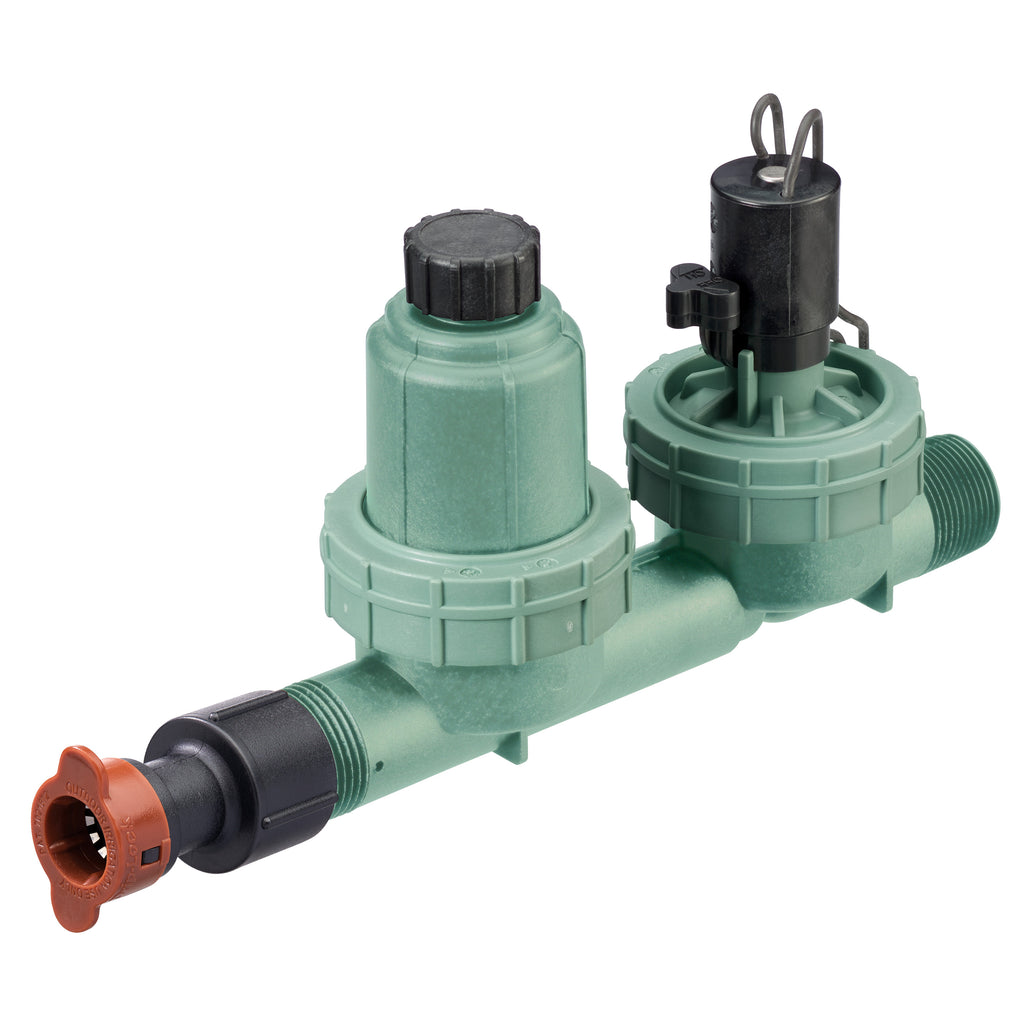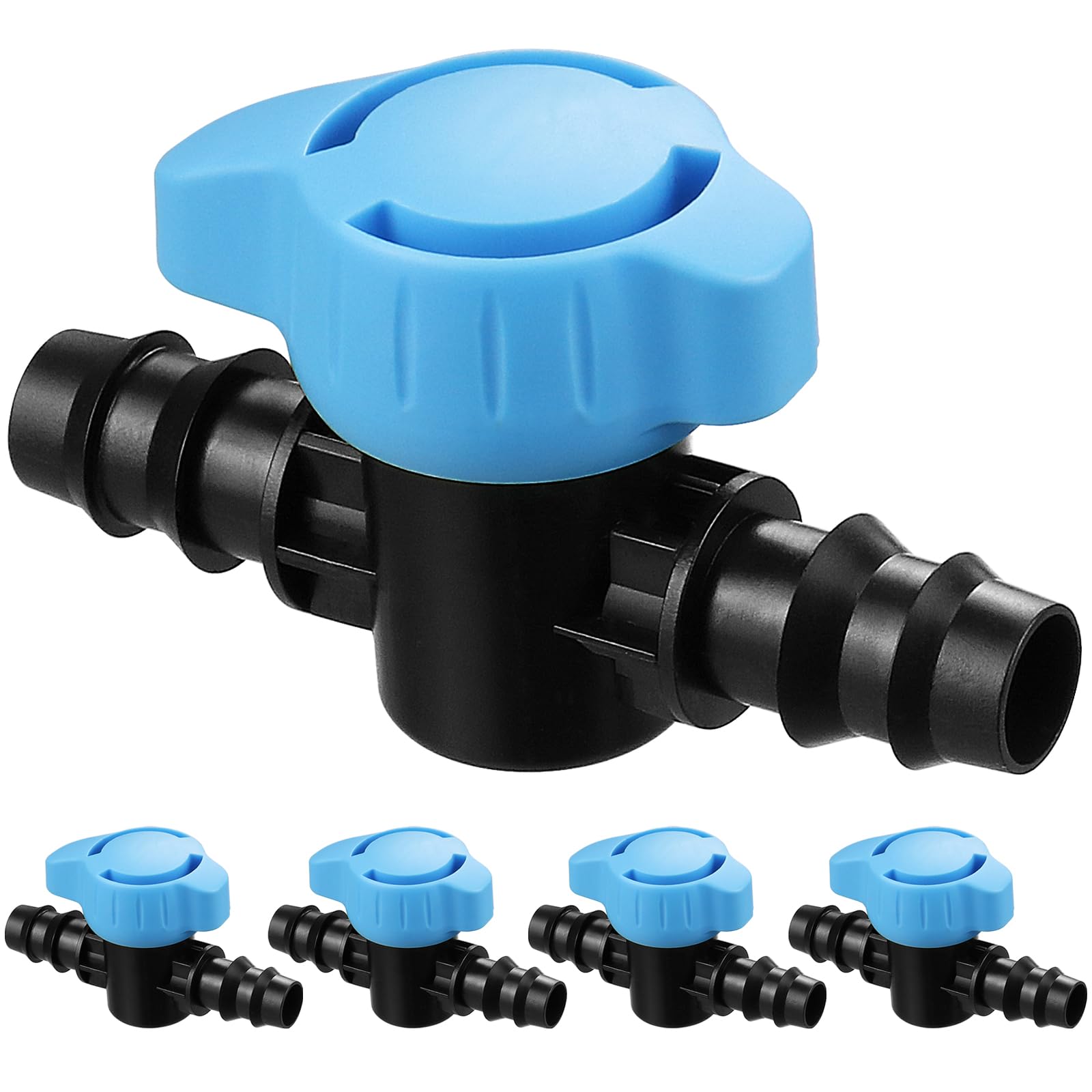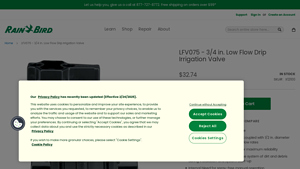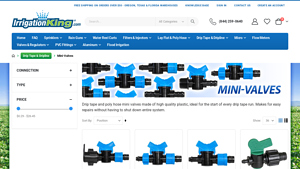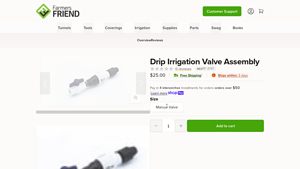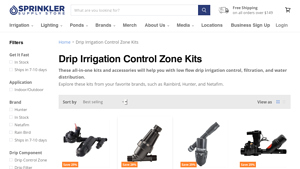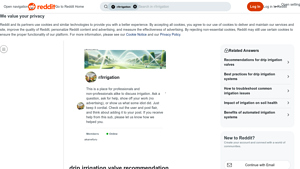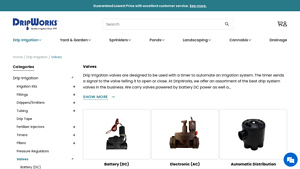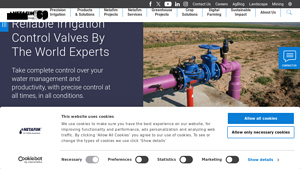Introduction: Navigating the Global Market for drip irrigation valve
In an increasingly competitive agricultural landscape, sourcing the right drip irrigation valve can be a pivotal challenge for international B2B buyers. The need for efficient water management solutions is paramount, particularly in regions such as Africa, South America, the Middle East, and Europe, where water scarcity is a pressing concern. This comprehensive guide addresses the complexities of navigating the global market for drip irrigation valves, providing insights into various types, applications, and the critical importance of supplier vetting.
From understanding the nuances of inline versus ball valves to exploring innovative technologies that enhance system efficiency, this guide equips buyers with the knowledge needed to make informed purchasing decisions. We delve into cost considerations, regulatory standards, and the significance of selecting reliable suppliers that meet international quality benchmarks.
By leveraging the insights provided herein, B2B buyers can streamline their procurement processes, ensuring that they invest in products that not only meet their operational needs but also contribute to sustainable agricultural practices. Whether you’re a distributor, farmer, or agricultural engineer, this guide serves as a valuable resource to enhance your understanding of drip irrigation valves and optimize your purchasing strategy in a global market.
Understanding drip irrigation valve Types and Variations
| Type Name | Key Distinguishing Features | Primary B2B Applications | Brief Pros & Cons for Buyers |
|---|---|---|---|
| Inline Shut-Off Valves | Integrated design for low flow, easy manual operation | Agricultural fields, greenhouses | Pros: Simple installation, cost-effective. Cons: Limited flow control. |
| Pressure-Regulating Valves | Maintains consistent pressure, prevents over-pressurization | Large-scale farms, commercial nurseries | Pros: Ensures uniform water distribution. Cons: Higher initial cost. |
| Mini-Valves | Compact size, ideal for localized control | Home gardens, small agricultural setups | Pros: Space-efficient, versatile. Cons: Limited flow capacity. |
| Ball Valves | Durable construction, provides quick shut-off | Industrial applications, municipal systems | Pros: Reliable and long-lasting. Cons: Can be more expensive. |
| Low Flow Valves | Designed specifically for low flow rates, effective particle handling | Specialty crops, sensitive environments | Pros: Prevents clogging, suitable for delicate systems. Cons: May require more maintenance. |
What Are Inline Shut-Off Valves and Their Applications?
Inline shut-off valves are specifically designed for drip irrigation systems, allowing for easy manual control of water flow. They are characterized by their simple installation and low cost, making them suitable for agricultural fields and greenhouses where budget constraints may be a concern. Buyers should consider the ease of installation and the need for flow control when selecting these valves, as they may not offer advanced features for regulating water pressure.
How Do Pressure-Regulating Valves Benefit Large-Scale Operations?
Pressure-regulating valves are essential in maintaining consistent water pressure throughout drip irrigation systems. This feature is particularly important for large-scale farms and commercial nurseries, where uneven pressure can lead to inefficient water usage. While these valves may come with a higher upfront cost, their ability to ensure uniform water distribution can result in long-term savings and healthier crops, making them a worthwhile investment for serious agricultural operations.
Why Choose Mini-Valves for Small-Scale Irrigation?
Mini-valves are compact and versatile, making them ideal for localized control in home gardens and small agricultural setups. Their small size allows for easy integration into tight spaces, providing flexibility in irrigation design. Buyers should weigh the advantages of space efficiency against the limited flow capacity, particularly if they require a robust system for larger areas.
What Are the Advantages of Using Ball Valves in Industrial Settings?
Ball valves are known for their durability and reliability, making them a popular choice for industrial applications and municipal systems. They provide quick shut-off capabilities, which can be crucial in managing large water supplies. Although ball valves can be more expensive than other types, their long lifespan and low maintenance needs often justify the investment for businesses looking for dependable irrigation solutions.
How Do Low Flow Valves Support Sensitive Crop Environments?
Low flow valves are engineered to handle the specific needs of drip irrigation systems operating at low flow rates. This makes them particularly beneficial for specialty crops and sensitive environments where clogging can be a significant issue. While they may require more maintenance than standard valves, their ability to prevent clogging and manage delicate systems makes them a valuable asset for growers focused on quality and efficiency.
Key Industrial Applications of drip irrigation valve
| Industry/Sector | Specific Application of drip irrigation valve | Value/Benefit for the Business | Key Sourcing Considerations for this Application |
|---|---|---|---|
| Agriculture | Precision irrigation in crop farming | Maximizes water efficiency, reducing costs | Compatibility with existing systems and flow rates |
| Horticulture | Controlled watering for nurseries and greenhouses | Ensures optimal growth conditions for plants | Durability against varying environmental conditions |
| Landscaping | Automated irrigation for residential and commercial landscaping | Enhances aesthetic value and reduces labor costs | Size and type of valve suitable for diverse plant needs |
| Golf Course Management | Irrigation systems for fairways and greens | Maintains turf health while conserving water | Ability to handle low flow rates and pressure stability |
| Viticulture | Water management in vineyards | Improves grape quality and yield | Resistance to clogging and compatibility with fertigation |
How Are Drip Irrigation Valves Used in Agriculture?
In the agricultural sector, drip irrigation valves are integral for precision irrigation, allowing farmers to deliver water directly to the root zone of crops. This targeted watering technique minimizes waste and maximizes efficiency, essential in regions where water is scarce. Buyers in this sector should consider compatibility with existing irrigation systems, as well as flow rate specifications to ensure optimal performance.
What Role Do Drip Irrigation Valves Play in Horticulture?
Horticulture relies heavily on controlled watering systems, particularly in nurseries and greenhouses. Drip irrigation valves enable consistent moisture levels, crucial for the healthy growth of various plants. For international buyers, durability against harsh conditions and the ability to manage varying flow rates are key considerations when sourcing these valves.
How Are Drip Irrigation Valves Beneficial for Landscaping?
In landscaping, drip irrigation valves automate the watering process for both residential and commercial projects. This automation not only enhances the aesthetic appeal of landscapes but also significantly reduces labor costs associated with manual watering. Sourcing considerations should include the size and type of valve to cater to diverse plant requirements, ensuring that the system meets specific design needs.
Why Are Drip Irrigation Valves Important for Golf Course Management?
Golf courses utilize drip irrigation valves to maintain the health of fairways and greens, ensuring optimal turf conditions while conserving water. These valves help in managing low flow rates essential for delicate grass types. Buyers should prioritize valves with pressure stability and low maintenance needs to ensure long-term reliability in various climatic conditions.
How Do Drip Irrigation Valves Impact Viticulture?
In viticulture, effective water management is crucial for improving grape quality and yield. Drip irrigation valves facilitate the precise delivery of water, which is particularly important during critical growth phases. Buyers in this sector should look for valves that resist clogging and are compatible with fertigation systems, as these features enhance the overall efficiency of vineyard irrigation.
3 Common User Pain Points for ‘drip irrigation valve’ & Their Solutions
Scenario 1: Difficulty in Selecting the Right Valve for Low Flow Applications
The Problem: Many B2B buyers in agriculture or landscaping struggle with selecting the appropriate drip irrigation valve for low flow systems. When working with delicate crops or specific irrigation needs, the risk of overwatering or under-watering can severely impact crop yields. Buyers often face a lack of clarity on which valve can handle low flow rates while preventing issues such as clogging from sediment or debris. This uncertainty can lead to costly mistakes and ineffective irrigation strategies.
The Solution: To address this issue, buyers should focus on sourcing valves specifically designed for low flow rates, such as the Rain Bird LFV075 valve, which operates efficiently at 0.2 to 8.0 gallons per minute. These valves are engineered with a unique diaphragm that allows particles to pass through without causing blockages, thus ensuring consistent performance. When specifying a valve, it’s crucial to consider the specific flow requirements of the irrigation system and the potential for debris. Buyers should also consult with manufacturers to understand the filtration systems that can be paired with these valves to enhance reliability. Implementing a pre-filter upstream of the valve can further minimize clogging risks, ensuring a smooth irrigation process.
Scenario 2: High Maintenance Costs Due to Valve Failures
The Problem: Another common challenge for B2B buyers is the high maintenance costs associated with frequent valve failures. These failures can stem from poor quality materials, inadequate design for the specific irrigation environment, or lack of proper installation. For businesses that rely on consistent irrigation schedules, such interruptions not only increase operational costs but can also lead to significant agricultural losses.
The Solution: To mitigate maintenance issues, buyers should prioritize the procurement of high-quality valves made from durable materials, such as PVC or brass, which can withstand the rigors of varying temperatures and pressures. Additionally, investing in valves with built-in features like external bleed for manual flushing can prevent debris accumulation and prolong the valve’s lifespan. Buyers should also ensure proper installation by following manufacturer guidelines and considering professional installation services if necessary. Regular maintenance checks and timely replacements of any worn components can further reduce the likelihood of failures, ultimately leading to lower long-term operational costs.
Scenario 3: Complexity in System Integration and Automation
The Problem: Many buyers encounter difficulties when attempting to integrate drip irrigation valves into existing automated systems. The complexity of coordinating different components—such as timers, sensors, and valves—can lead to inefficiencies and increased labor costs. This challenge is exacerbated in regions with varying water quality, where specific valves might be needed to accommodate local conditions.
The Solution: To effectively integrate drip irrigation valves into automated systems, buyers should seek out valves that are compatible with smart irrigation technologies. For instance, valves that support 24 VAC solenoids can easily connect to automated timers and controllers. It’s essential to work closely with system integrators or irrigation specialists who can provide guidance on the best practices for setup and compatibility. Furthermore, buyers should consider investing in valves that feature adjustable flow rates, which allows for easier calibration and fine-tuning based on real-time data from soil moisture sensors. This proactive approach not only enhances the efficiency of the irrigation system but also helps in optimizing water usage, making it a sustainable solution for agricultural practices.
Strategic Material Selection Guide for drip irrigation valve
What Are the Key Materials Used in Drip Irrigation Valves?
When selecting drip irrigation valves, the choice of material significantly influences performance, durability, and cost. Here, we analyze four common materials used in the manufacturing of these valves: PVC, brass, stainless steel, and polyethylene. Each material has distinct properties, advantages, and limitations that can impact their suitability for various applications, particularly in diverse international markets.
How Does PVC Perform in Drip Irrigation Valves?
Key Properties: PVC (Polyvinyl Chloride) is known for its excellent chemical resistance, lightweight nature, and good pressure ratings, typically up to 150 psi. It is also resistant to corrosion and UV degradation, making it suitable for outdoor applications.
Pros & Cons: The primary advantage of PVC is its low cost and ease of installation, which makes it a popular choice for large-scale irrigation projects. However, it has lower temperature resistance compared to metals and can become brittle in extreme cold, potentially leading to cracks.
Impact on Application: PVC is compatible with a wide range of media, including water and fertilizers. However, it may not be suitable for high-temperature applications or where extreme pressure fluctuations are expected.
Considerations for International Buyers: Buyers in regions like Africa and South America should ensure compliance with local standards such as ASTM or ISO. PVC is widely accepted, but awareness of local regulations regarding chemical leaching is crucial.
What Are the Benefits of Using Brass in Drip Irrigation Valves?
Key Properties: Brass is a durable alloy made primarily of copper and zinc, offering excellent strength and corrosion resistance. It can handle higher pressure ratings, typically up to 300 psi, and operates effectively in a wide temperature range.
Pros & Cons: The main advantage of brass is its longevity and reliability, making it ideal for high-pressure applications. However, brass is more expensive than PVC and can be prone to corrosion in acidic environments.
Impact on Application: Brass valves are suitable for potable water applications and can handle various media, including acidic solutions. Their robustness makes them ideal for regions with fluctuating temperatures.
Considerations for International Buyers: Buyers from Europe and the Middle East should verify compliance with standards like DIN and BS. The higher cost may be justified for applications requiring durability and reliability.
Why Choose Stainless Steel for Drip Irrigation Valves?
Key Properties: Stainless steel is known for its exceptional corrosion resistance, strength, and ability to withstand high temperatures and pressures. It typically has a pressure rating exceeding 400 psi, making it suitable for demanding environments.
Pros & Cons: The key advantage of stainless steel is its durability and resistance to rust, which ensures a long lifespan. However, it is the most expensive option among the materials discussed, and its manufacturing process can be complex.
Impact on Application: Stainless steel valves are ideal for aggressive media and environments with high salinity, such as coastal areas. They are also suitable for applications requiring high hygiene standards, such as in food production.
Considerations for International Buyers: Buyers should consider compliance with international standards like JIS and ASTM. The investment in stainless steel may be worthwhile for long-term applications, especially in regions with stringent regulations.
What Role Does Polyethylene Play in Drip Irrigation Valves?
Key Properties: Polyethylene is a lightweight, flexible plastic known for its resistance to chemicals and UV radiation. It typically operates at lower pressure ratings, around 60 psi, making it suitable for low-pressure applications.
Pros & Cons: The primary advantage of polyethylene is its flexibility and resistance to cracking, which makes it easy to install in various configurations. However, it has lower durability compared to metals and may degrade over time when exposed to UV light.
Impact on Application: Polyethylene valves are ideal for drip irrigation systems in agricultural settings where low pressure is common. They are compatible with various fertilizers and pesticides.
Considerations for International Buyers: Buyers in regions with intense sunlight, such as Africa, should consider UV-stabilized polyethylene to prevent degradation. Compliance with local standards is essential to ensure quality.
Summary Table of Material Selection for Drip Irrigation Valves
| Material | Typical Use Case for drip irrigation valve | Key Advantage | Key Disadvantage/Limitation | Relative Cost (Low/Med/High) |
|---|---|---|---|---|
| PVC | General irrigation systems | Low cost and easy installation | Brittle in extreme cold | Low |
| Brass | High-pressure applications | Durable and reliable | Higher cost, corrosion in acids | Med |
| Stainless Steel | Aggressive media and high hygiene needs | Exceptional corrosion resistance | Most expensive, complex manufacturing | High |
| Polyethylene | Low-pressure agricultural applications | Flexible and resistant to cracking | Lower durability, UV degradation | Low |
This guide provides a comprehensive overview of the materials used in drip irrigation valves, enabling international B2B buyers to make informed decisions based on their specific needs and regional considerations.
In-depth Look: Manufacturing Processes and Quality Assurance for drip irrigation valve
What Are the Key Stages in the Manufacturing Process of Drip Irrigation Valves?
The manufacturing process of drip irrigation valves consists of several critical stages that ensure high-quality products are produced efficiently.
Material Preparation: The first step involves selecting and preparing raw materials, typically high-grade plastics or metals, which are essential for durability and performance in various environmental conditions. Quality checks on incoming materials are crucial to ensure they meet specific industry standards.
Forming: In this stage, materials are molded or extruded into the required valve shapes. Techniques such as injection molding for plastics or casting for metals are commonly used. Precision in this stage is vital, as the valve’s functionality relies on exact dimensions and shapes to prevent leaks and ensure proper flow control.
Assembly: Once individual components are formed, they are assembled into the final product. This may involve fitting diaphragms, seals, and other internal parts that contribute to the valve’s operational efficiency. Automated assembly lines are often employed to enhance precision and speed.
Finishing: The final stage includes surface treatment, which may involve polishing, coating, or adding protective finishes to enhance corrosion resistance and durability. Quality assurance during this stage focuses on ensuring that all aesthetic and functional aspects of the valve meet customer specifications.
How Is Quality Assurance Implemented Throughout the Manufacturing Process?
Quality assurance (QA) is an integral part of the manufacturing process, ensuring that drip irrigation valves meet international standards and customer expectations.
International Standards: Compliance with standards such as ISO 9001 is critical. This standard focuses on quality management systems and ensures that manufacturers consistently provide products that meet customer and regulatory requirements. For specific markets, certifications like CE (Conformité Européenne) for Europe and API (American Petroleum Institute) for relevant applications may also be necessary.
Quality Control Checkpoints:
– Incoming Quality Control (IQC): This involves inspecting raw materials before they enter the production line to ensure they meet specified quality criteria.
– In-Process Quality Control (IPQC): During production, regular checks are made to monitor the quality of components as they are formed and assembled. This may include dimensional checks and functional tests.
– Final Quality Control (FQC): After assembly and finishing, the complete product undergoes rigorous testing, including pressure tests, flow rate tests, and leak tests, to verify functionality and durability.Common Testing Methods: Manufacturers often employ various testing techniques, including:
– Hydraulic testing to assess pressure tolerance.
– Flow testing to evaluate the valve’s performance under different flow conditions.
– Durability testing to simulate long-term use and environmental exposure.
How Can B2B Buyers Verify Supplier Quality Control Measures?
When engaging with suppliers, particularly in international markets, B2B buyers should take proactive steps to verify quality control measures.
Supplier Audits: Conducting on-site audits allows buyers to assess the manufacturing processes and quality control systems in place. This includes reviewing documentation, observing production practices, and evaluating the implementation of quality standards.
Quality Assurance Reports: Requesting detailed quality assurance reports from suppliers can provide insights into their QC processes, including test results and compliance with international standards. This documentation should be regularly updated to reflect current practices.
Third-Party Inspections: Engaging third-party inspection agencies can offer an unbiased assessment of the supplier’s quality control practices. These agencies can perform random checks on production batches and ensure compliance with relevant standards.
What Are the Nuances of Quality Control for International B2B Buyers?
International B2B buyers, especially those from diverse regions such as Africa, South America, the Middle East, and Europe, must navigate specific nuances related to quality control.
Understanding Regional Standards: Different regions may have varying quality standards and certifications. Buyers should familiarize themselves with the regulations applicable to their markets. For instance, products sold in Europe must meet CE marking requirements, while those sold in the United States may require compliance with ASTM standards.
Cultural and Communication Barriers: Effective communication is vital in ensuring that quality expectations are clearly understood by suppliers. Cultural differences may impact how quality is perceived, so it’s essential to establish clear guidelines and expectations from the outset.
Supply Chain Transparency: Buyers should seek suppliers that maintain transparency throughout their supply chains. This includes traceability of materials and components, which is crucial for ensuring product quality and compliance with safety regulations.
Post-Sale Support and Warranty: Assessing a supplier’s post-sale support and warranty policies can provide insights into their commitment to quality. Reliable suppliers often offer warranties that reflect their confidence in their product quality, which can be a significant factor for B2B buyers.
Conclusion
Understanding the manufacturing processes and quality assurance measures for drip irrigation valves is essential for B2B buyers aiming to procure reliable products. By focusing on material preparation, forming, assembly, and finishing, alongside robust quality control mechanisms, manufacturers can ensure high standards. B2B buyers should actively engage in verifying these processes through audits, reports, and inspections, while also considering regional standards and cultural nuances to make informed purchasing decisions.
Practical Sourcing Guide: A Step-by-Step Checklist for ‘drip irrigation valve’
Introduction
This sourcing guide aims to assist international B2B buyers in procuring drip irrigation valves effectively. With the growing demand for efficient water management solutions, understanding the critical steps in sourcing quality valves is essential. This checklist will help you navigate the complexities of selecting the right products and suppliers to meet your irrigation needs.
Step 1: Define Your Technical Specifications
Establish clear technical specifications for the drip irrigation valves you require. Consider factors such as flow rates, pressure ratings, and compatibility with existing irrigation systems.
– Flow Rate Requirements: Ensure the valves can handle the specific flow rates needed for your agricultural or horticultural applications.
– Material Selection: Decide on materials that resist corrosion and wear, especially in regions with varying climate conditions.
Step 2: Research Potential Suppliers
Conduct thorough research to identify potential suppliers specializing in drip irrigation valves. Look for suppliers with a proven track record in your target regions, such as Africa, South America, the Middle East, and Europe.
– Reputation and Reviews: Check online reviews, industry forums, and case studies to gauge supplier reliability.
– Product Range: Ensure suppliers offer a diverse range of valves to meet different irrigation needs.
Step 3: Evaluate Supplier Certifications and Compliance
Verify that potential suppliers have the necessary certifications and comply with industry standards. This step is crucial to ensure product quality and safety.
– ISO Certifications: Look for ISO 9001 or other relevant certifications that indicate quality management systems.
– Local Compliance: Ensure products meet local regulations and standards, which can vary significantly by region.
Step 4: Request Samples for Testing
Before making a bulk purchase, request samples of the drip irrigation valves. Testing samples will allow you to assess product quality and compatibility with your systems.
– Performance Testing: Evaluate the valves under real-world conditions to ensure they meet your specifications.
– Durability Assessment: Check for any signs of wear or malfunction during testing to gauge long-term reliability.
Step 5: Negotiate Pricing and Terms
Once you have identified a suitable supplier, initiate negotiations to establish pricing and terms. This step is essential for securing the best deal while ensuring quality.
– Volume Discounts: Inquire about discounts for bulk purchases, which can significantly reduce costs.
– Payment Terms: Clarify payment terms, including deposits, payment schedules, and any financing options available.
Step 6: Confirm Delivery and Logistics
Establish clear expectations regarding delivery timelines and logistics. This step ensures that you receive your valves on time and in good condition.
– Shipping Methods: Discuss shipping options that align with your project timelines.
– Customs and Duties: Be aware of any customs regulations or duties that may apply to your shipments, especially for international orders.
Step 7: Monitor After-Sales Support and Warranty
Evaluate the after-sales support and warranty terms provided by the supplier. Strong after-sales support can be vital for troubleshooting and maintenance.
– Technical Support: Ensure that the supplier offers robust technical support to address any issues post-purchase.
– Warranty Coverage: Understand warranty terms, including what is covered and the duration of coverage, to protect your investment.
By following this checklist, B2B buyers can effectively navigate the sourcing process for drip irrigation valves, ensuring they make informed decisions that align with their operational needs.
Comprehensive Cost and Pricing Analysis for drip irrigation valve Sourcing
What Are the Key Cost Components for Drip Irrigation Valve Sourcing?
Understanding the cost structure of drip irrigation valves is essential for B2B buyers aiming to make informed purchasing decisions. The primary cost components include materials, labor, manufacturing overhead, tooling, quality control (QC), logistics, and profit margins.
Materials: The choice of materials significantly impacts the overall cost. High-quality plastic or brass is often used for durability, particularly in harsh climates. Buyers should evaluate the material specifications to ensure they meet the operational requirements of their irrigation systems.
Labor: Labor costs can vary depending on the region and the expertise required for assembly. Automation in manufacturing may reduce these costs, but it is essential to balance efficiency with product quality.
Manufacturing Overhead: This includes costs associated with factory operation, utilities, and maintenance. Buyers should inquire about the supplier’s production capabilities and overhead management to understand how these factors might influence pricing.
Tooling: The initial investment in tools and molds can be substantial, especially for custom designs. Buyers looking for unique specifications may face higher costs due to these upfront tooling investments.
Quality Control (QC): Implementing rigorous QC measures can enhance product reliability but may also increase costs. It is advisable to request details about the QC processes to ensure that the valves meet the necessary quality standards.
Logistics: Shipping and handling costs can vary greatly based on distance, mode of transport, and volume. International buyers should consider logistics as a critical component of total expenses, as these costs can significantly affect the final price.
Margin: Suppliers typically add a margin to cover their costs and ensure profitability. Understanding the typical margins in the industry can help buyers gauge whether a quote is competitive.
How Do Price Influencers Affect Drip Irrigation Valve Costs?
Several factors influence the pricing of drip irrigation valves, and B2B buyers should consider them when negotiating.
Volume/MOQ: Minimum order quantities (MOQ) can affect pricing. Larger orders typically lead to lower per-unit costs due to economies of scale. Buyers should assess their needs to negotiate favorable terms.
Specifications/Customization: Custom specifications can lead to increased costs. Buyers should weigh the benefits of tailored solutions against the potential price hike.
Materials: The choice of materials impacts not only the price but also the longevity and performance of the valves. High-quality materials may command a premium, but they can also reduce maintenance costs in the long run.
Quality/Certifications: Valves that meet international standards or come with certifications may be priced higher. However, this can assure buyers of reliability and compliance with local regulations.
Supplier Factors: Supplier reputation, experience, and reliability are crucial. Established suppliers may charge a premium but often provide better service and quality assurance.
Incoterms: Understanding shipping terms is vital for international transactions. Incoterms define the responsibilities of buyers and sellers concerning shipping, insurance, and tariffs, which can influence the total cost.
What Are the Best Negotiation Tips for B2B Buyers of Drip Irrigation Valves?
Effective negotiation can lead to significant savings and improved supplier relationships. Here are some tips tailored for B2B buyers, particularly in regions like Africa, South America, the Middle East, and Europe:
Research Market Prices: Understand the prevailing market prices for similar valves. This knowledge can empower buyers to negotiate better deals.
Consider Total Cost of Ownership: When evaluating suppliers, consider not just the initial purchase price but the total cost of ownership, including maintenance, warranty, and potential downtime.
Leverage Volume Discounts: If possible, consolidate orders to meet MOQs and secure volume discounts.
Build Relationships: Establishing long-term relationships with suppliers can lead to better pricing, priority service, and favorable terms in future negotiations.
Be Flexible: Being open to alternative solutions, such as different materials or specifications, can help in securing better prices.
Understand Local Regulations: Buyers should be aware of any import duties, taxes, or local regulations that could impact the final cost of the valves.
In conclusion, understanding the cost structure and pricing influencers is crucial for B2B buyers in the drip irrigation valve market. By applying these insights and negotiation strategies, buyers can optimize their procurement process and achieve better value for their investments.
Alternatives Analysis: Comparing drip irrigation valve With Other Solutions
Understanding Alternative Solutions to Drip Irrigation Valves
In the agricultural and irrigation sectors, selecting the right irrigation technology is crucial for efficiency and productivity. While drip irrigation valves are widely recognized for their precision and water conservation capabilities, several alternative solutions exist that may better suit specific operational needs. This section compares drip irrigation valves with two alternative methods: sprinkler irrigation systems and surface irrigation techniques.
Comparison Table
| Comparison Aspect | Drip Irrigation Valve | Sprinkler Irrigation System | Surface Irrigation Technique |
|---|---|---|---|
| Performance | High efficiency; minimizes water loss; ideal for high-value crops | Moderate efficiency; can cover large areas quickly | Variable efficiency; dependent on soil type and slope |
| Cost | Moderate initial investment; low long-term operating costs | Higher initial setup costs; increased water and energy costs | Low initial investment; potentially high labor costs |
| Ease of Implementation | Requires careful planning and installation | Easier to install on large fields; flexible design | Simple to implement but may require land leveling |
| Maintenance | Low maintenance; regular checks needed | Moderate maintenance; moving parts require regular servicing | Low maintenance; occasional checks for blockages |
| Best Use Case | Ideal for row crops, orchards, and greenhouse applications | Suitable for large fields and diverse crop types | Effective for flood-prone areas and pasture lands |
Detailed Breakdown of Alternatives
Sprinkler Irrigation System
Sprinkler systems work by spraying water over crops in a manner akin to rainfall. They are particularly advantageous for large fields where rapid coverage is needed. The primary benefit of this system is its ability to irrigate a wide range of crops efficiently, especially in areas with variable topography. However, they have a higher initial cost due to the need for pumps and pipes, and they can lead to increased water evaporation and runoff, particularly in hot climates.
Surface Irrigation Technique
Surface irrigation involves the distribution of water over the soil surface, allowing it to flow and soak into the ground. This method is one of the oldest and simplest forms of irrigation, often requiring little investment. It is most beneficial in flood-prone regions or for crops that thrive in moist conditions. However, surface irrigation can be inefficient due to evaporation losses and uneven distribution, heavily reliant on soil properties and topography. It also often necessitates significant labor for setup and management.
Conclusion: Choosing the Right Irrigation Solution
For B2B buyers, the decision on which irrigation solution to adopt should depend on several factors, including crop type, field size, water availability, and budget. Drip irrigation valves are excellent for precision watering and are especially beneficial for high-value crops in arid regions, while sprinkler systems may be more suitable for larger, diverse agricultural settings. Surface irrigation, although simpler and cost-effective, might not provide the efficiency needed for all crops. Evaluating the specific requirements of your agricultural operations will lead to a more informed and strategic choice, ensuring maximum productivity and sustainability in your irrigation practices.
Essential Technical Properties and Trade Terminology for drip irrigation valve
What Are the Key Technical Properties of Drip Irrigation Valves?
Understanding the technical specifications of drip irrigation valves is crucial for international B2B buyers looking to make informed purchasing decisions. Here are some essential properties to consider:
1. Material Grade
Drip irrigation valves are typically made from high-density polyethylene (HDPE), PVC, or brass. Each material offers different durability and resistance to chemicals and UV rays. For instance, HDPE valves are lightweight and resistant to corrosion, making them ideal for various environmental conditions, especially in regions with high salinity or chemical exposure.
2. Flow Rate
The flow rate, measured in gallons per minute (GPM) or liters per minute (L/min), is a critical specification. It determines how much water can pass through the valve at any given time, which is vital for ensuring efficient irrigation. For example, low-flow valves designed for drip systems typically handle rates as low as 0.2 GPM, which is essential for minimizing water wastage.
3. Pressure Rating
Valves come with specific pressure ratings, usually expressed in pounds per square inch (psi) or bars. This rating indicates the maximum pressure the valve can withstand without failing. A higher pressure rating allows for better performance in systems where pressure fluctuations are common, ensuring consistent water delivery.
4. Diaphragm Design
The diaphragm design plays a significant role in valve operation, especially in low-flow systems. A double-knife diaphragm, for instance, can handle particles more effectively, preventing clogging and ensuring smooth operation. This feature is particularly beneficial in agricultural settings where sediment may be present in the water supply.
5. Electrical Specifications
For automated systems, electrical specifications such as voltage (typically 24 VAC for solenoid-operated valves) and current ratings are essential. Understanding these specifications ensures compatibility with existing irrigation control systems, thereby streamlining installation and operation.
6. Size and Connection Types
Drip irrigation valves come in various sizes (e.g., 1/4″, 1/2″, 3/4″) and connection types (barbed, threaded). Selecting the appropriate size and type is crucial for ensuring a proper fit within the irrigation system, which can prevent leaks and ensure optimal performance.
What Are Common Trade Terms Used in the Drip Irrigation Industry?
Familiarity with trade terminology is essential for effective communication and negotiation in the B2B market. Here are some commonly used terms:
1. OEM (Original Equipment Manufacturer)
OEM refers to a company that produces parts or equipment that may be marketed by another manufacturer. In the context of drip irrigation, an OEM may supply valves or components that are integrated into larger irrigation systems. Understanding OEM relationships can help buyers ensure quality and compatibility.
2. MOQ (Minimum Order Quantity)
MOQ is the smallest quantity of a product that a supplier is willing to sell. For B2B buyers, knowing the MOQ can help in budgeting and inventory management, particularly for large-scale agricultural operations that require consistent supplies.
3. RFQ (Request for Quotation)
An RFQ is a document that a buyer sends to suppliers to request pricing and terms for specific products. This process is critical for negotiating costs and understanding the financial aspects of purchasing drip irrigation valves.
4. Incoterms (International Commercial Terms)
Incoterms define the responsibilities of buyers and sellers in international trade, specifying who pays for shipping, insurance, and tariffs. Familiarity with these terms helps buyers understand their obligations and reduce risks in cross-border transactions.
5. Lead Time
Lead time refers to the time it takes from placing an order to receiving the goods. Understanding lead times is essential for planning and ensuring that irrigation systems are operational when needed, particularly in agricultural seasons.
6. Warranty and Service Agreements
Warranty terms and service agreements outline the manufacturer’s responsibilities regarding product defects and repairs. Buyers should carefully review these terms to ensure they are covered for potential issues, especially in regions where access to replacement parts may be limited.
By grasping these technical properties and trade terms, B2B buyers can make well-informed decisions when sourcing drip irrigation valves, ultimately leading to improved efficiency and effectiveness in their irrigation systems.
Navigating Market Dynamics and Sourcing Trends in the drip irrigation valve Sector
What Are the Current Market Dynamics and Key Trends in the Drip Irrigation Valve Sector?
The global drip irrigation valve market is witnessing substantial growth driven by increasing water scarcity, rising agricultural productivity demands, and the need for sustainable farming practices. In regions like Africa and South America, where agriculture is a primary economic activity, the adoption of efficient irrigation systems is crucial. This demand is further fueled by government initiatives promoting water conservation and the use of advanced irrigation technologies.
Emerging trends include the integration of smart technology in drip irrigation systems, such as automated valves and IoT-enabled monitoring solutions. These innovations allow for precise control over water usage, reducing waste and optimizing crop yields. For international B2B buyers, particularly those from Europe, the Middle East, and Asia, sourcing high-quality valves that can withstand varying environmental conditions is essential. A growing emphasis on durability and reliability is prompting buyers to seek suppliers who can provide robust products tailored to specific regional challenges.
Additionally, as e-commerce platforms become more prevalent, buyers can expect enhanced transparency regarding product specifications, pricing, and availability. Digital marketplaces are streamlining the sourcing process, enabling buyers to compare options and make informed decisions efficiently.
How Can Sustainability and Ethical Sourcing Influence B2B Decisions in the Drip Irrigation Valve Market?
Sustainability is increasingly becoming a focal point for businesses involved in the drip irrigation valve sector. The environmental impact of traditional irrigation practices has led to a growing demand for products that minimize water usage and reduce chemical runoff. For B2B buyers, selecting valves made from sustainable materials and designed for low water flow rates is crucial. Products that are certified as eco-friendly not only meet regulatory requirements but also resonate with consumers who prioritize sustainability.
Ethical sourcing practices are also gaining importance. Buyers are encouraged to partner with suppliers who maintain transparent supply chains, ensuring that the materials used in production are sourced responsibly. Certifications such as ISO 14001 (Environmental Management) and others related to sustainable manufacturing can serve as indicators of a supplier’s commitment to environmental stewardship.
By prioritizing sustainability and ethical sourcing, businesses can not only enhance their brand reputation but also meet the growing consumer demand for responsible products. This approach can lead to long-term cost savings, improved operational efficiencies, and a stronger competitive edge in the marketplace.
What Is the Brief Evolution of Drip Irrigation Valves in the B2B Context?
The evolution of drip irrigation valves can be traced back to the early 20th century when the need for efficient water management in agriculture became apparent. Initially, these systems were rudimentary, consisting of basic mechanical components that lacked the precision required for modern agricultural practices.
Over the decades, advancements in materials science and engineering have led to the development of specialized valves designed to operate effectively at low flow rates. The introduction of automated and electronically controlled valves has revolutionized the sector, allowing for real-time monitoring and adjustments that enhance water efficiency.
Today, the market is characterized by an array of innovative products that cater to diverse agricultural needs across different geographies. As B2B buyers seek reliable and technologically advanced solutions, the drip irrigation valve sector continues to adapt, ensuring that it meets the demands of a rapidly changing agricultural landscape.
Frequently Asked Questions (FAQs) for B2B Buyers of drip irrigation valve
How do I solve issues with drip irrigation valve leaks?
To address leaks in drip irrigation valves, first, identify the source of the leak, which could be due to worn-out seals, loose fittings, or debris obstructing the valve. Ensure that all connections are tight and free from corrosion. If the valve has a replaceable diaphragm or seal, consider replacing it. Regular maintenance and cleaning of the valve can prevent dirt accumulation and ensure smooth operation. If leaks persist, consult with your supplier for potential replacement options or upgrades to more reliable models.What is the best type of drip irrigation valve for low-flow applications?
For low-flow applications, such as those found in delicate crops or smaller gardens, a low-flow drip irrigation valve is ideal. These valves are specifically designed to operate efficiently at flow rates between 0.2 to 8.0 gallons per minute (gpm). Look for valves featuring a double-filtered pilot flow design, which can handle particles without clogging, ensuring consistent water delivery. Brands like Rain Bird offer specialized low-flow valves that enhance system reliability and performance.How do I evaluate and select a reliable supplier for drip irrigation valves?
When sourcing suppliers for drip irrigation valves, start by reviewing their industry reputation and customer feedback. Look for suppliers who provide comprehensive product specifications and have a history of successful international trade, especially in your target regions. Verify their certifications and compliance with international standards, such as ISO or CE marking. It’s also beneficial to request samples to assess product quality before committing to larger orders.What are the typical minimum order quantities (MOQs) for drip irrigation valves?
Minimum order quantities for drip irrigation valves can vary significantly by supplier and region. Generally, MOQs can range from as low as 50 to several hundred units, depending on the valve type and supplier capabilities. When negotiating, consider discussing flexible MOQs, especially if you are a new buyer or testing a new product line. This can help manage initial investment risks while allowing you to gauge market demand.What payment terms should I expect when purchasing drip irrigation valves internationally?
Payment terms for international purchases typically vary by supplier and may include options such as upfront payment, partial payment upon order confirmation, and the balance upon shipment. Common methods include bank transfers, letters of credit, or payment platforms like PayPal. Always negotiate terms that protect your interests, such as escrow services, especially for first-time transactions. Ensure that all terms are clearly documented in the sales agreement to avoid misunderstandings.How can I customize drip irrigation valves for my specific needs?
Many suppliers offer customization options for drip irrigation valves, including size, material, and flow rate adjustments. To initiate customization, provide detailed specifications and requirements to your supplier, including any unique features necessary for your irrigation system. Discuss lead times and costs associated with custom orders, as these can differ from standard products. Collaborating closely with your supplier ensures that the final product meets your operational needs.What quality assurance (QA) measures should I look for in drip irrigation valves?
When sourcing drip irrigation valves, inquire about the supplier’s quality assurance processes. Look for manufacturers who implement rigorous testing protocols, including flow rate tests, durability assessments, and pressure tests. Certifications from recognized bodies can also indicate compliance with international quality standards. Request documentation of QA processes and consider conducting audits or factory visits to verify these practices before finalizing your order.What logistics considerations should I keep in mind for importing drip irrigation valves?
When importing drip irrigation valves, logistics play a crucial role in ensuring timely delivery. Evaluate shipping options, including air freight for faster delivery or sea freight for cost-effective shipping, depending on your urgency and budget. Be aware of customs regulations and potential tariffs in your country that may affect overall costs. Working with a freight forwarder can streamline the import process, helping you navigate documentation and compliance requirements efficiently.
Important Disclaimer & Terms of Use
⚠️ Important Disclaimer
The information provided in this guide, including content regarding manufacturers, technical specifications, and market analysis, is for informational and educational purposes only. It does not constitute professional procurement advice, financial advice, or legal advice.
While we have made every effort to ensure the accuracy and timeliness of the information, we are not responsible for any errors, omissions, or outdated information. Market conditions, company details, and technical standards are subject to change.
B2B buyers must conduct their own independent and thorough due diligence before making any purchasing decisions. This includes contacting suppliers directly, verifying certifications, requesting samples, and seeking professional consultation. The risk of relying on any information in this guide is borne solely by the reader.
Top 7 Drip Irrigation Valve Manufacturers & Suppliers List
1. Rain Bird – LFV075 Low Flow Drip Irrigation Valve
Domain: store.rainbird.com
Registered: 1995 (30 years)
Introduction: {“model”:”LFV075″,”type”:”3/4 in. Low Flow Drip Irrigation Valve”,”special_price”:”$32.74″,”list_price”:”$43.65″,”flow_range”:”0.2 to 8 gpm (0.6 to 30 l/m)”,”pressure_range”:”15 to 150 psi (1.0 to 10.3 bars)”,”electrical_specifications”:{“voltage”:”24 VAC”,”frequency”:”50/60 Hz”,”inrush_current”:”0.30 A (7.2 VA) at 60 Hz”,”holding_current”:”0.19 A (4.56 VA)”},”features”:[“Unique ‘double-knife’ dia…
2. Irrigation King – Drip Tape Mini-Valves
Domain: irrigationking.com
Registered: 2016 (9 years)
Introduction: Drip Tape Mini-Valves made of high quality plastic, ideal for the start of every drip tape run. Allows for easy repairs without shutting down the entire system. Various types available including Starter Mini-Valve with different connections such as Lay Flat Hose x 5/8″ Tape Swivel, 10 mm locking Insert x 5/8″ Tape Swivel, 10 mm Barb x 5/8″ Tape Swivel, and more. Prices range from $0.29 to $2.40 de…
3. Farmers Friend – Drip Irrigation Valve Assembly
Domain: farmersfriend.com
Registered: 2004 (21 years)
Introduction: {“product_name”: “Drip Irrigation Valve Assembly”, “SKU”: “FF-2747”, “price”: “$25.00”, “shipping”: “Free Shipping”, “shipping_time”: “Ships within: 3 days”, “reviews”: {“rating”: “0.00 out of 5 stars”, “count”: “0 reviews”}, “payment_options”: “Pay in 4 interest-free installments for orders over $50”, “product_options”: [“Size”, “Manual Valve”, “Decrement”, “Increment”]}
4. Netafim – Control Zone Kit Low Flow
Domain: sprinklersupplystore.com
Registered: 2010 (15 years)
Introduction: [{‘name’: ‘Netafim – LVCZ10075-LF – Control Zone Kit Low Flow’, ‘original_price’: 133.03, ‘current_price’: 99.78, ‘in_stock’: 9, ‘features’: ‘1″ FPT Inlet x 3/4″ MPT Outlet, Designed for all dripperline, drip and micro-spray zones’}, {‘name’: ‘Hunter – HY075 – 3/4 in. NPT WYE Filter’, ‘original_price’: 27.15, ‘current_price’: 19.68, ‘in_stock’: 19, ‘features’: ‘Replacement WYE Filter Assembly for …
5. Hunter – Drip Zone Kits
Domain: reddit.com
Registered: 2005 (20 years)
Introduction: Drip irrigation valves recommended include Hunter and Rainbird. It’s suggested to use combination valves with filter/regulators, known as drip zone kits. The working pressure range for drip irrigation is about 15-50 psi, with regulators typically reducing pressure to 40 psi. For larger drip zones (over 1000 ft), regulation may not be necessary if the unregulated source pressure is around 60 psi an…
6. DripWorks – Drip Irrigation Valves
Domain: dripworks.com
Registered: 1998 (27 years)
Introduction: Drip irrigation valves are designed to be used with a timer to automate an irrigation system. They can be powered by battery DC power or household AC current. Automatic distribution valves powered by water flow are also available for applications without electricity. Valves are compatible with timers and must match the pressure and flow rate of the irrigation system. Direct-burial wire and wire co…
7. Netafim – Precision Valves for Drip Irrigation
Domain: netafim.com
Registered: 1996 (29 years)
Introduction: Netafim offers a range of valves for drip irrigation, including 300 Series Metal Butterfly Valves, Angle Seat Valves, Gate Valves, Check Valves, Y strainers, and various pilots, relays, and floats. Their valves are designed for precise control over water management and productivity, addressing challenges such as making delicate adjustments and shutting off main and sub-main lines. The HydroCalc va…
Strategic Sourcing Conclusion and Outlook for drip irrigation valve
In conclusion, strategic sourcing of drip irrigation valves is essential for optimizing water management in agricultural practices across diverse global markets. By focusing on quality, reliability, and cost-effectiveness, buyers can ensure they select valves that enhance system efficiency and longevity. The growing demand for sustainable agricultural solutions in regions such as Africa, South America, the Middle East, and Europe underscores the importance of investing in specialized products that cater to local needs.
As international B2B buyers explore options, they should prioritize suppliers who offer innovative designs and robust support services. Understanding the unique requirements of drip irrigation systems will enable buyers to make informed decisions that align with their operational goals.
Looking ahead, the market for drip irrigation valves is poised for growth, driven by advancements in technology and an increasing emphasis on water conservation. Engaging with reputable suppliers and leveraging strategic sourcing practices will empower buyers to not only enhance their agricultural productivity but also contribute to sustainable practices. Take the next step in your procurement strategy by evaluating your options and investing in quality drip irrigation valves that meet your specific needs.

